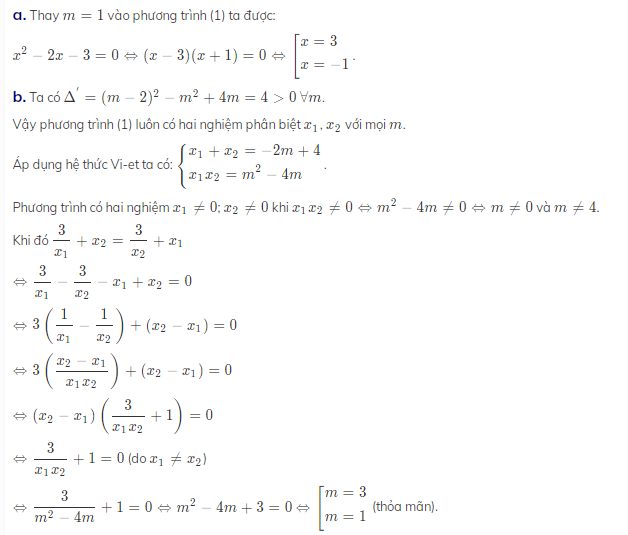Hãy nhập câu hỏi của bạn vào đây, nếu là tài khoản VIP, bạn sẽ được ưu tiên trả lời.

1,
Thay m=4 phuong trình đã cho trở thành : \(x^2-9x+20=0\)
\(\Delta=81-80=1\) \(>0\) nên phương trình đã cho có hai nghiệm phân biệt \(x_1=5\) và \(x_2=4\).
2,
Ta có \(\Delta=\left(2m+1\right)^2-4\left(m^2+m\right)=1>0\) với mọi \(m\) nên phuong trình đã cho có hai nghiệm phân biệt
\(x_1,x_2\) với mọi \(m.\)
Áp dụng định lý Vi-et : \(\hept{\begin{cases}x_1+x_2=2m+1\\x_1x_2=m^2+m\end{cases}}\)
\(\Rightarrow x_1^2+x_2^2-5x_1x_2=-17\) \(\Leftrightarrow\left(x_1+x_2\right)^2-7x_1x=-17\Leftrightarrow\left(2m+1\right)^2-7\left(m^2+m\right)=-17\Leftrightarrow m^2+m-6=0\)
\(\Rightarrow\hept{\begin{cases}m=-3\\m=2\end{cases}}\)

a, Thay m = -1 vào phương trình trên ta được
\(x^2+4x-5=0\)
Ta có : \(\Delta=16+20=36\)
\(x_1=\frac{-4-6}{2}=-5;x_2=\frac{-4+6}{2}=1\)
Vậy với m = -1 thì x = -5 ; x = 1
b, Vì x = 2 là nghiệm của phương trình trên nên thay x = 2 vào phương trình trên ta được :
\(4+8+3m-2=0\Leftrightarrow3m=-10\Leftrightarrow m=-\frac{10}{3}\)
Vậy với x = 2 thì m = -10/3
c, Để phương trình có 2 nghiệm phân biệt thì \(\Delta>0\)hay
\(16-4\left(3m-2\right)=16-12m+8=4m+8>0\)
\(\Leftrightarrow8>-4m\Leftrightarrow m>-2\)
Theo Vi et ta có : \(\hept{\begin{cases}x_1+x_2=-\frac{b}{a}=-4\\x_1x_2=\frac{c}{a}=3m-2\end{cases}}\)
\(\Leftrightarrow x_1+x_2=-4\Leftrightarrow x_1=-4-x_2\)(1)
suy ra : \(-4-x_2+2x_2=1\Leftrightarrow-4+x_2=1\Leftrightarrow x_2=5\)
Thay vào (1) ta được : \(x_1=-4-5=-9\)
Mà \(x_1x_2=3m-2\Rightarrow3m-2=-45\Leftrightarrow3m=-43\Leftrightarrow m=-\frac{43}{3}\)

a, \(x^2-4x+3=0\Leftrightarrow x^2-x-3x+3=0\)
\(\Leftrightarrow x\left(x-1\right)-3\left(x-1\right)=0\Leftrightarrow\left(x-3\right)\left(x-1\right)=0\Leftrightarrow\orbr{\begin{cases}x=3\\x=1\end{cases}}\)
Vậy tập nghiệm của phương trình là S = { 1 ; 3 }
b, Ta có : \(\Delta=\left(2m+2\right)^2-4\left(2m-5\right)=4m^2+8m+4-8m+20=4m^2+24>0\forall m\)
Theo Vi et ta có : \(\hept{\begin{cases}x_1+x_2=-\frac{b}{a}=2m-2\\x_1x_2=\frac{c}{a}=2m-5\end{cases}}\)
Ta có : \(\left(x_1^2-2mx_1-x_2+2m-3\right)\left(x_2^2-2mx_2-x_1+2m-3\right)=19.1=1.19\)
TH1 : \(\hept{\begin{cases}x_1^2-2mx_1-x_2+2m-3=19\\x_2^2-2mx_2-x_1+2m-3=1\end{cases}}\)
Lấy phương trình (1) + (2) ta được :
\(x_1^2+x_2^2-2mx_1-2mx_2-x_2-x_1+4m-6=20\)
mà \(\left(x_1+x_2\right)^2=4m^2+8m+4\Rightarrow x_1^2+x_2^2=4m^2+8m+4-2x_1x_2\)
\(=4m^2+8m+4-2\left(2m-5\right)=4m^2+4m-6\)
\(\Leftrightarrow4m^2+4m-6-2m\left(2m-2\right)-\left(2m-2\right)+4m-6=20\)
\(\Leftrightarrow4m^2+4m-6-4m^2+4m-2m+2+4m-6=20\)
\(\Leftrightarrow10m=30\Leftrightarrow m=3\)tương tự với TH2, nhưng em ko chắc lắm vì dạng này em chưa làm bao giờ

\(x^2+mx+4=0\left(1\right)\)
+)Vì phương trình có 1 nghiệm là -1, do đó theo tính chất nhấm nghiệm thì có \(a-b+c=0\)
⇒ nghiệm còn lại là \(-4\).
+) Để phương trình có nghiệm thì \(\Delta\ge0\) hay \(m^2-16\ge0\Leftrightarrow\left[{}\begin{matrix}m\le-4\\m\ge4\end{matrix}\right.\)
Theo viét : \(\left\{{}\begin{matrix}x_1+x_2=-m\\x_1x_2=4\end{matrix}\right.\)
Có : \(x_1^2+x^2_2=6m-13\)
\(\Leftrightarrow\left(x_1+x_2\right)^2-2x_1x_2=6m-13\)
\(\Leftrightarrow m^2-8=6m-13\)
\(\Leftrightarrow m^2-6m+5=0\Leftrightarrow\left(m-1\right)\left(m-5\right)=0\Leftrightarrow\left[{}\begin{matrix}m=1\left(l\right)\\m=5\left(n\right)\end{matrix}\right.\)
Vậy...

\(x^2-2\left(m+1\right)x+3m-3=0\left(1\right)\)
\(\Delta'>0\Leftrightarrow\left(m+1\right)^2-\left(3m-3\right)=m^2-m+4>0\left(đúng\forall m\right)\)
\(đk\) \(tồn\) \(tại:\sqrt{x1-1}+\sqrt{x2-1}\)
\(\Leftrightarrow1\le x1< x2\Leftrightarrow\left\{{}\begin{matrix}\left(x1-1\right)\left(x2-1\right)\ge0\\x1+x2-2>0\end{matrix}\right.\)
\(\Leftrightarrow\left\{{}\begin{matrix}x1x2-\left(x1+x2\right)+1\ge0\\2\left(m+1\right)-2>0\end{matrix}\right.\Leftrightarrow\left\{{}\begin{matrix}3m-2-2\left(m+1\right)+1\ge0\\m>0\end{matrix}\right.\)
\(\Leftrightarrow m\ge4\)
\(\Rightarrow\sqrt{x1-1}+\sqrt{x2-1}=4\Leftrightarrow x1+x2-2+2\sqrt{\left(x1-1\right)\left(x2-1\right)}=16\)
\(\Leftrightarrow2\left(m+1\right)+2\sqrt{x1.x2-\left(x1+x2\right)+1}=18\)
\(\Leftrightarrow\left(m+1\right)+\sqrt{3m-3-2\left(m+1\right)+1}=9\)
\(\Leftrightarrow m-4+\sqrt{m-4}=4\)
\(đặt:\sqrt{m-4}=t\ge0\Rightarrow t^2+t=4\Leftrightarrow\left[{}\begin{matrix}t=\dfrac{-1+\sqrt{17}}{21}\left(tm\right)\\t=\dfrac{-1-\sqrt{17}}{21}\left(ktm\right)\end{matrix}\right.\)
\(\Rightarrow\sqrt{m-4}=\dfrac{-1+\sqrt{17}}{21}\Leftrightarrow m=....\)
\(\)

Ta có \(ac=-m^2-2< 0\) ; \(\forall m\) nên pt đã cho luôn có 2 nghiệm trái dấu
Mà \(x_1< x_2\Rightarrow\left\{{}\begin{matrix}x_1< 0\\x_2>0\end{matrix}\right.\) \(\Rightarrow\left\{{}\begin{matrix}\left|x_1\right|=-x_1\\\left|x_2\right|=x_2\end{matrix}\right.\)
\(\Rightarrow2\left|x_1\right|-\left|x_2\right|=4\Leftrightarrow-2x_1-x_2=4\)
Kết hợp với hệ thức Viet: \(x_1+x_2=-m+1\)
\(\Rightarrow\left\{{}\begin{matrix}-2x_1-x_2=4\\x_1+x_2=-m+1\end{matrix}\right.\) \(\Rightarrow\left\{{}\begin{matrix}-x_1=-m+5\\x_1+x_2=-m+1\end{matrix}\right.\)
\(\Rightarrow\left\{{}\begin{matrix}x_1=m-5\\x_2=-2m+6\end{matrix}\right.\)
Thay vào \(x_1x_2=-m^2-2\)
\(\Rightarrow\left(m-5\right)\left(-2m+6\right)=-m^2-2\)
\(\Leftrightarrow m^2-16m+28=0\Rightarrow\left[{}\begin{matrix}m=2\\m=14\end{matrix}\right.\)

\(x^2-2\left(m+1\right)x+3\left(m+1\right)-3=0\)
\(x^2-2nx+3n+3=\left(x-n\right)^2-\left(n^2-3n+3\right)=0\)\(\left(x-n\right)^2=\left(n-\frac{3}{2}\right)^2+\frac{3}{4}=\frac{\left(2n-3\right)^2+3}{4}>0\forall n\) vậy luôn tồn tại hai nghiệm
\(\orbr{\begin{cases}x_1=\frac{n-\sqrt{\left(2n-3\right)^2+3}}{2}\\x_2=\frac{n+\sqrt{\left(2n-3\right)^2+3}}{2}\end{cases}}\)
a) \(\frac{x_1}{x_2}=\frac{4x_1-x_2}{x_1}\Leftrightarrow\frac{x_1^2-4x_1x_2+x_2^2}{x_1x_2}=0\)
\(x_1x_2=n^2-\frac{\left(2n-3\right)^2+3}{4}=\frac{4n^2-4n^2+12n-9-3}{4}=3n-3\)
với n=1 hay m=0 : Biểu thức cần C/m không tồn tại => xem lại đề



